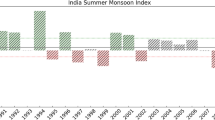Abstract
Despite the long history of investigation of foehn phenomena, there are few studies of the influence of foehn winds on air pollution and none in the Dead Sea valley. For the first time the foehn phenomenon and its effects on local dust pollution, frontal cloudiness and surface solar radiation were analyzed in the Dead Sea valley, as it occurred on 22 March 2013. This was carried out using both numerical simulations and observations. The foehn winds intensified local dust emissions, while the foehn-induced temperature inversion trapped dust particles beneath this inversion. These two factors caused extreme surface dust concentration in the western Dead Sea valley. The dust pollution was transported by west winds eastward, to the central Dead Sea valley, where the speed of these winds sharply decreased. The transported dust was captured by the ascending airflow contributing to the maximum aerosol optical depth (AOD) over the central Dead Sea valley. On the day under study, the maximum surface dust concentration did not coincide with the maximum AOD: this being one of the specific effects of the foehn phenomenon on dust pollution in the Dead Sea valley. Radar data showed a passage of frontal cloudiness through the area of the Dead Sea valley leading to a sharp drop in noon solar radiation. The descending airflow over the downwind side of the Judean Mountains led to the formation of a cloud-free band followed by only the partial recovery of solar radiation because of the extreme dust pollution caused by foehn winds.















Similar content being viewed by others
References
Baldauf M, Seifert A, Förstner J, Majewski D, Raschendorfer M, Reinhardt T (2011) Operational convective-scale numerical weather prediction with the COSMO model: description and sensitivities. Mon Weather Rev 139(12):3887–3905. doi:10.1175/MWR-D-10-05013.1
Brinkmann WAR (1971) What is foehn? Weather 26:230–239. doi:10.1002/j.1477-8696.1971.tb04200.x
Callot Y, Marticorena B, Bergametti G (2000) Geomorphologic approach for modelling the surface features of arid environments in a model of dust emissions: application to the Sahara desert. Geodin Acta 13(5):245–270. doi:10.1016/S0985-3111(00)01044-5
Drechsel S, Mayr GJ (2008) Objective forecasting of foehn winds for a subgrid-scale Alpine valley. Weather and Forecasting 23, pp. 205–218, doi:10.1175/2007WAF2006021.1
Gohm A, Harnisch F, Vergeiner J, Obleitner F, Schnitzhofer R, Hansel A, Fix A, Neiniger B, Emeis S, Schafer K (2009) Air pollution transport in an Alpine valley: results from airborne and ground-based observations. Bound Layer Meteorol 131:441–463. doi:10.1007/s10546-009-9371-9
Hecht A, Gertman I (2003) Dead Sea meteorological climate. In: Nevo E, Oren A, Wasser S P (eds) Fungal life in the Dead Sea. A. R. G. Ganter, Ruggell, Lichtenstein, pp. 68–114
Kishcha P, Rieger D, Metzger J, Starobinets B, Bangert M, Vogel H, Schaettler U, Corsmeier U, Alpert P, Vogel B (2016) Modeling of a strong dust event in the complex terrain of the Dead Sea valley during the passage of a gust front. Tellus B 68:29751. doi:10.3402/tellusb.v68.29751
Li X, Xia X, Wang L, Cai R, Zhao L, Feng Z, Ren Q, Zhao K (2015) The role of foehn in the formation of heavy air pollution events in Urumqi, China. J Geophys Res Atmos 120:5371–5384. doi:10.1002/2014JD022778
Marticorena B (2014) Dust production mechanisms. In: Knippertz P, Stuut J-B (eds) Mineral dust. A key player in the Earth system. Springer, Dordrecht
Marticorena B, Bergametti G, Aumont B, Callot Y, N’doumé C, Legrand M (1997) Modeling the atmospheric dust cycle: 2. Simulation of Saharan dust sources. J Geophys Res Atmos 102(D4):4387–4404. doi:10.1029/96JD02964
McGowan HA, Sturman PA, Owens FL (1996) Aeolian dust transport and deposition by foehn winds in an alpine environment, Lake Tekapo, New Zealand. Geomorphology 15(2):135–146. doi:10.1016/0169-555X(95)00123-M
McGowan HA, Sturman AP, Kossmann M, Zawar-Reza P (2002) Observation of foehn onset in the Southern Alps, New Zealand. Meteorol Atmos Phys 79:215–230. doi:10.1007/s007030200004
Nkemdirim LC, Leggat K (1978) The effect of chinook weather on urban heat islands and air pollution. Water Air Soil Pollut 9:53–67. doi:10.1007/BF00185747
Norte FA (2015) Understanding and Forecasting Zonda Wind (Andean Foehn) in Argentina: a Review. Atmos Clim Sci 5:163–193. doi:10.4236/acs.2015.53012
Richner H, Hachler P (2013) Understanding and forecasting Alpine foehn, in Mountain Weather Research and Forecasting, Monogr. Springer Atmospheric Sciences Series, Chapter 4, Springer, Netherlands, pp 219–260. doi:10.1007/978-94-007-4098-3_4
Takane Y, Kusaka H (2011) Formation mechanisms of the extreme high surface air temperature of 40.9 °C observed in the Tokyo metropolitan area: considerations of dynamic foehn and foehnlike wind. Journal of Applied Meteorology and Climatology 50:1827–1841. doi:10.1175/JAMC-D-10-05032.1
Vogel B, Hoose C, Vogel H, Kottmeier C (2006) A model of dust transport applied to the Dead Sea area. Meteorol Z 15:611–624. doi:10.1127/0941-2948/2006/0168
Vogel B, Vogel H, Bäumer D, Bangert M, Lundgren K, Rinke R, Stanelle T (2009) The comprehensive model system COSMO-ART—radiative impact of aerosol on the state of the atmosphere on the regional scale. Atmos Chem Phys 9:8661–8680. doi:10.5194/acp-9-8661-2009
Acknowledgements
This study was made with support from the international Virtual Institute DESERVE (Dead Sea Research Venue), funded by the German Helmholtz Association. Special thanks to the Israel Oceanographic and Limnological Research for providing the meteorological data taken at the Dead Sea buoy.
Author information
Authors and Affiliations
Corresponding author
Additional information
Responsible Editor: J.-F. Miao.
Rights and permissions
About this article
Cite this article
Kishcha, P., Starobinets, B., Savir, A. et al. Foehn-induced effects on local dust pollution, frontal clouds and solar radiation in the Dead Sea valley. Meteorol Atmos Phys 130, 295–309 (2018). https://doi.org/10.1007/s00703-017-0521-1
Received:
Accepted:
Published:
Issue Date:
DOI: https://doi.org/10.1007/s00703-017-0521-1




